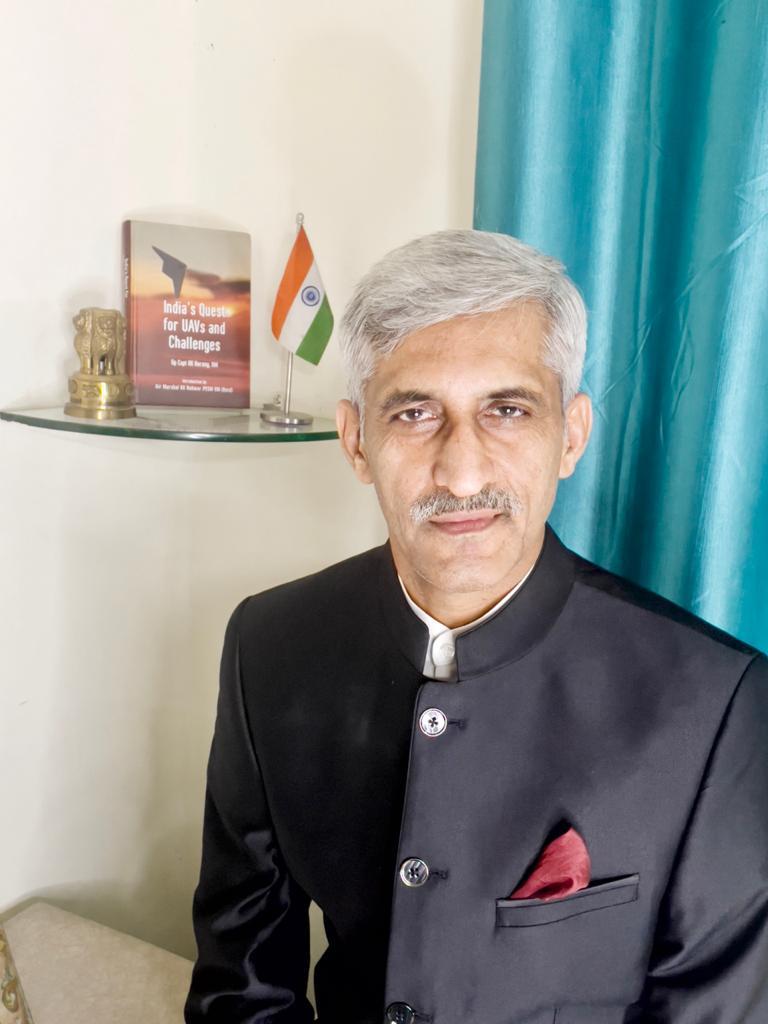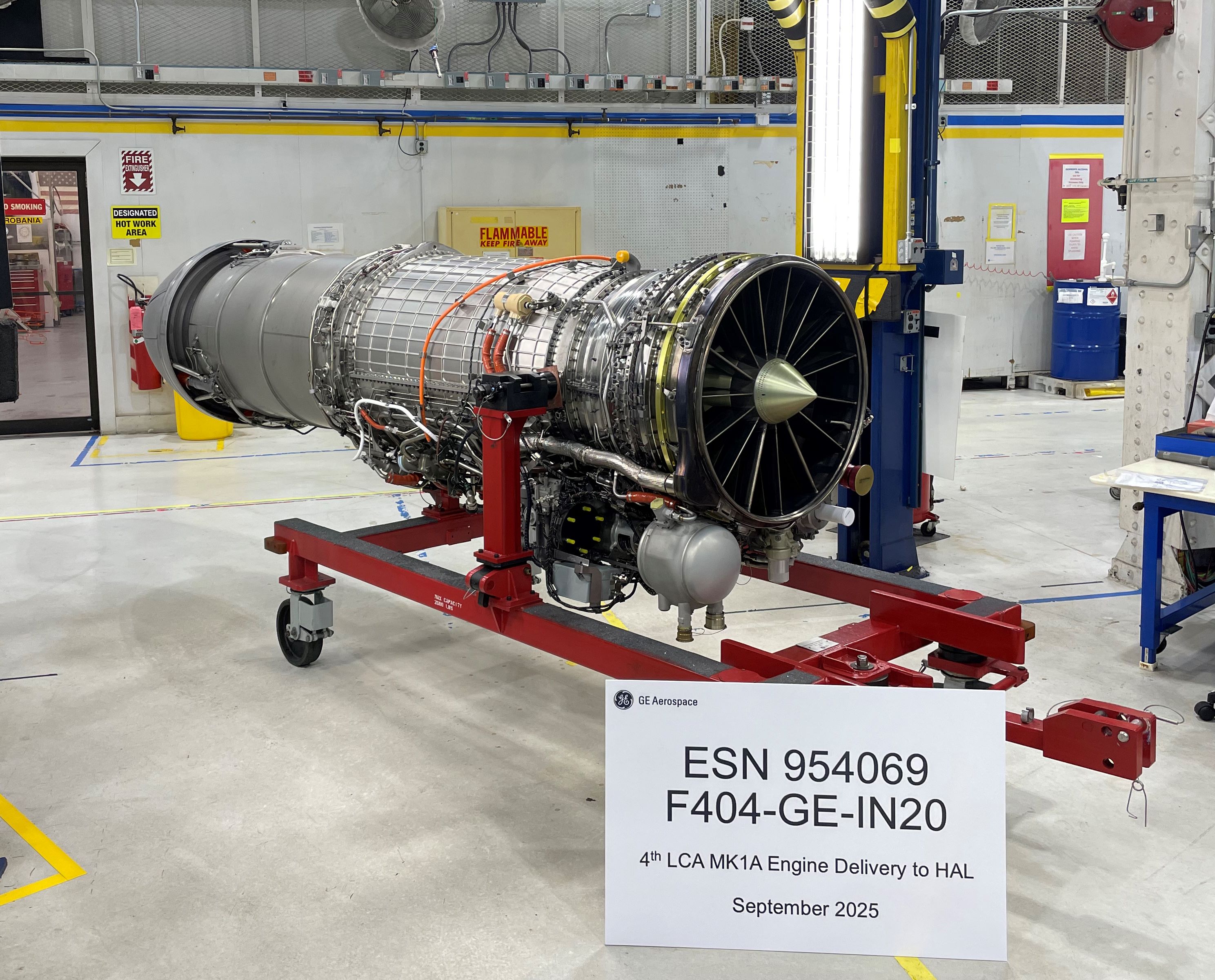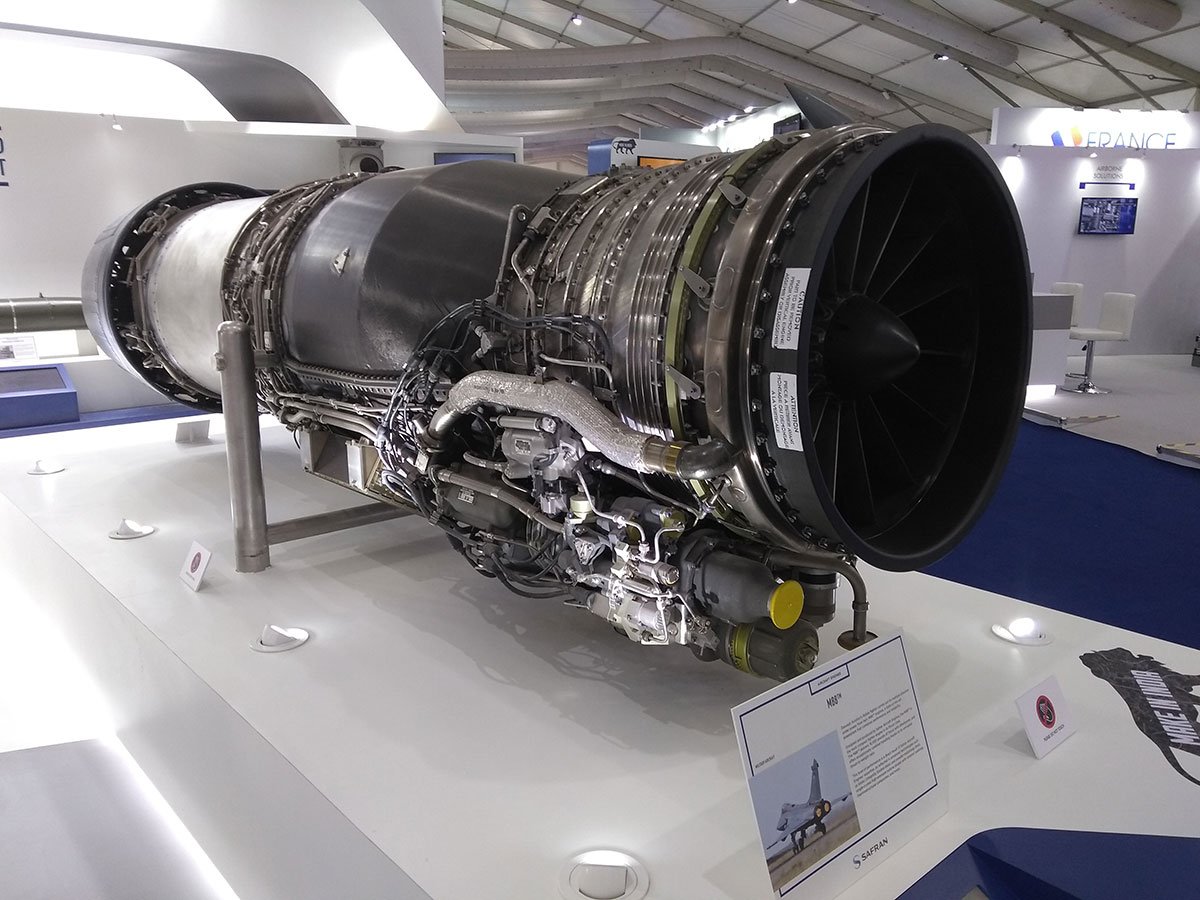Make and Build in India
Self-reliance in aero engines through Safran deal will help bypass
delays
 Gp Capt. R. K. Narang
(retd)
Gp Capt. R. K. Narang
(retd)
Prime Minister Narendra Modi’s call for building indigenous aero engines in his speech at the Red Fort on 15 August 2025 highlights the significance of this critical technology. Indian ministry of defence (MoD) and Safran company of France are in the final stage of negotiations to codevelop 120 kN class of aero engine for the fifth generation Advanced Medium Combat Aircraft (AMCA).
India’s indigenous aero engine development programme,
i.e., Kaveri (after-burner variant) has been closed, and its future remains
uncertain. The lack of high-altitude wind tunnel and Flight Test Bed (FTB),
design and development challenges, paucity of manpower, meagre funding,
technology denial, organisational limitations and other challenges contributed
to delays in the development and operationalisation of Kaveri engine.
Indigenous development of aero engine should not be closed as co-development is
not same as indigenous development. Therefore, technical review of Kaveri
engine is needed with an aim to identify critical gaps, formulate a roadmap to
make it successful, or launch next phase of development of indigenous aero engine
to achieve aatmanirbharta in true sense.
The deal with Safran to co-develop 120 kN engine is
likely to be based on existing core of M88 aero engine of France and
co-development from this phase onwards would enable India to produce these
engines in India with reasonable level of strategic autonomy. However, it would
still leave certain knowledge gaps that would pose limitations on India
becoming self-reliant in the true sense. Therefore, it is important to identify
suitable measures to optimally leverage deal with Safran to fill technology and
capability gaps to achieve strategic autonomy in manufacturing, modifications
and upgrades while actively pursuing development of indigenous aero engines.
The article therefore, deliberates on firstly,
achievements and challenges of after-burner Kaveri engine programme; secondly,
limitations of Kaveri Derivative Engine, and its contribution to self-reliance;
thirdly, testing and ecosystem gaps; fourthly, identifying measure for achieving
strategic autonomy in the Safran deal; and finally, significance of launching
Kaveri 2.0 engine development programme to make India self-reliant in aero engine
technologies.
Kaveri Engine Achievements
India had launched its first-ever programme to develop 75-80 kN thrust
indigenous jet aero engine named Kaveri as power plant for its Light Combat
Aircraft (LCA) in 1989. It spent Rs 2,037 crores between 1989 and 2021 before
closing it down. It made significant progress in developing technologies as well
as faced setbacks and challenges. In the process of development of Kaveri
engine, a few of the Defence Research and Development Organisation’s (DRDO’s)
achievements include development of alloys, casting technology, certification
methodology and Advanced Full Authority Digital Electronic Controller
(A-FADEC). High altitude testing at Russian facilities enabled Indian
scientists to gain hands-on exposure to test procedures as well as immense
knowledge to interdependence of various technologies to overall performance of
aero engines.
Funding Challenges of Kaveri
Kaveri aero engine project has been criticised for cost overruns and delays; it faced funding challenges and initial funding demanded by Gas Turbine Research Establishment (GTRE) was Rs 382.81 crore, which was unrealistically low due to lack of understanding of design, testing and certification requirements. The development cost of Kaveri in due course increased to Rs 2,037 crore (USD 230.15 million), which was criticised in CAG reports for exceeding the initial estimates.

However, comparison of total funding of Kaveri engine
vis-a-vis other global players gives a different perspective. According to The Week magazine, Europe spent USD 1.6
billion for developing EJ 200 engine for Eurofighter between 1985 and 1995,
Dassault Rafale spent USD 1.6 billion till 1989, the US spent USD 6.7 billion
on its F 135 engine for F-35 fighter aircraft and China invested USD 42 billion
on its aero engine development programmes. The meagre investment in Kaveri
engine development by India posed limitations on pursuing the development,
overcoming its limitations as well as setting up of facilities for testing and
certification.
Impact of Import and Delinking: The decision to import GE-404 engine in 2007 had adverse impact on the
development trajectory of Kaveri engine, leading to its ultimate closure. The
delinking of Kaveri project from LCA in 2008 contributed to gradual decline of
interest for further developments in the Kaveri project.
Average Annual Funding: The study of total and average annual investment on the development of
Kaveri engine after 2009 can help in understanding its funding challenges post
GE-404 contract and delinking of Kaveri from LCA project. Out of a total of Rs
2,037 crores spent on Kaveri engine, Rs 1,996 crore was spent between 1989 and
2012, which works out to approximately Rs 86 crore per year. Similarly, a total
of Rs 41 crore was spent between 2012 and 2021, which works out to approximately
Rs 4.5 crore per year.
Overcoming Kaveri Challenges
Kaveri had achieved about 70-72 kN thrust, however its certification has not been completed. It is a fourth-generation engine, whose thrust to weight ratio is less than the current fifth generation aero engines. The generation of aero engine has no standard definition, especially so in India. The new generation of engine could mean better thrust to weight ratio, higher fuel efficiency and adoption of advanced technologies in engine design and manufacturing.

Kaveri faced a number of challenges during the process
of its development that comprise planning gaps, unrealistic cost projections,
changing of Probable Date of Completion (PDCs), components development
challenges, exceeding of All Up Weight (AUW) of aero-engine from 1,100kg to 1,235kg,
denial of raw materials, technology denials, international partners withdrawing
from co-development of enabling technologies, imposition of sanctions by the US
in 1998 post the nuclear test by India and exorbitant demands for technology
consultancies, etc. However, the crucial question remains whether an effort was
made to address these challenges and limitations to make Kaveri project
successful. Therefore, course corrections are needed.
KDE Limitations
In 2018, it was decided to take up modifications of after-burner Kaveri
engine into 49kN thrust non-after-burner variant, which is also known as Kaveri
Derivative Engine (KDE). KDE is being developed as a power plant for its
indigenous Unmanned Combat Aerial Vehicle (UCAV), also named as Remotely
Piloted Strike Aircraft (RPSA). KDE will require design modifications to meet
specific requirements of stealth RPSA. However, RPSA programme is yet to be
approved and integration of KDE with RPSA could take between six to eight years
after its approval. The KDE does not address the critical challenges faced by
the after-burner Kaveri variant and hence, will not help in indigenous
development of power plants for 4.5 generation LCA, 5.5 generation AMCA, their
operationalisation and future upgrades for the 6th generation aircraft and
beyond. Therefore, it is important to examine the significance and limitations
of KDE and the envisaged contribution of KDE programme towards self-reliance in
aero engines.
Building Testing Infrastructure
India had to pay huge sums, as well as wait for time slots, to utilise IL-76 Flight Test Bed (FTB) and High-Altitude Wind Tunnel in Russia for flight testing and high altitude testing respectively for after burner Kaveri as well as KDE. The Russia-Ukraine war, design delays and design deficiencies added to delays in the development of Kaveri engine. The availability of these testing facilities in India would have facilitated and accelerated development of Kaveri engine and its critical systems. Indian scientists would not have to wait for slots for testing in Russia for undertaking validation trials, instituting design improvements, and hence could have expedited its development. India needs to create its own design, testing and validation infrastructure to develop wide variety of turbojet, turbofan, turboshaft and turboprop aero engines as power plant for its fighter, transport and trainer aircraft, helicopter and Unmanned Aerial Vehicle (UAV) development projects. Currently, most of these programmes remain dependent on either import or on foreign technologies. The creation of testing facilities in India, therefore, is essential for seamless development of indigenous engines.

GE-404 Delivery Delays
The General Electric company of the US missed delivery schedules to supply
GE-404 engine on several occasions between 2023 and 2025, which highlights the
need to persist with indigenous aero-engine development programme. India’s LCA
programme is largely dependent on supply of these engines. The depleting fleet
of fighters has been a cause of concern for the IAF. The users are struggling
with depleting inventory and technological obsolescence. The slow rate of
production of LCA has also been under intense scrutiny of the media and users.
Therefore, the Indian public sector entity Hindustan Aeronautics Limited (HAL)
has been facing criticism due to the delays in supply of the LCA. Notably, the
delay in supply of GE-404 engine led to delay in production of LCA. HAL has
decided to make good the fighter shortfall by setting up three production lines
to manufacture 24 aircraft per year. It is hiring additional manpower, creating
manufacturing and testing infrastructure and has committed additional financial
resources; however, it remains unclear whether GE would scale up manufacturing
of GE-404 engines from 24 aircraft per year.
It is in this light that the indigenous engine would
provide India with strategic autonomy, and India cannot be held hostage to
delays by foreign Original Equipment Manufacturers (OEMs). Also, the deal with
Safran is still some time away, and its success depends on the trajectory of
development of the engine, technological challenges and cooperation of Safran
at each stage. The uncertainties and limitations associated with the Safran
deal necessitate focus to remain on making indigenous Kaveri engine successful,
while pursuing co-development of engine with Safran.
The delays in supply of GE-404 engine is a reminder of
the urgent need for self-reliance in critical aero-engine technologies. The
natural discourse should have been to revitalise Kaveri engine by carrying out
technical review, identifying weaknesses and plugging those gaps through
international collaborations or consultancies. India should not hesitate to
induct aero-engine experts in the Indian diaspora abroad, and experts of
foreign origin, if required, in such an endeavour. Identifying technological,
resources related, knowledge related and any other bottlenecks and challenges
and formulating a roadmap for indigenous development is vital and is still awaited.
Roadmap for Safran Deal
India should aim to achieve strategic autonomy in Safran deal while
simultaneously pursuing certification of the current after-burner Kaveri engine
and launching of Kaveri 2.0. This can be done by a joint team of GTRE, Indian
Air Force (IAF), Indian Navy (IN), Indian production partners and Safran
working together in formulation of qualitative requirements, design and
development of core and critical components of the engine.
Indian team must have equal workshare in the design,
testing, certification, integration and operationalisation of the critical
systems. Also, Safran should help in creating holistic aero-engine testing
infrastructure. Indian team should be part of all the testing, validation and
certification of the engine and its components. The certification data and
records should be held with Indian entities. India should also have control
over Intellectual Property Rights (IPR) of the engine and its critical
components, and it should be free to modify, upgrade and develop future
variants without needing approval from co-development partner. It should be
able to manufacture single crystal blade, turbine and other critical
technologies. These will enable India to manufacture engines without
restrictions, though there will remain certain limitations that can only be
bridged through an indigenous Kaveri 2.0.
Aatmanirbharta Through Kaveri 2.0
The further development of the after-burner Kaveri engine has been
discontinued. Shutting it down may prove to be a major setback for India’s
self-reliance trajectory in aero engines. The Kaveri engine, despite being a
fourth-generation engine, is an indigenous design effort. It is important to
understand the significance, challenges and limitations of after-burner Kaveri
and KDE projects to chart out a way forward to make India self-reliant in aero engine
technologies. Therefore, a three-pronged approach is recommended in the case of
the after-burner Kaveri engine.
Firstly, launch an initiative to overcome the
challenges of the after-burner Kaveri engine, and complete the certification
loop. This would help in obtaining real time experience of the process,
challenges and associated design improvements, which can further be an enabler
for developing fifth and sixth generation engines.
Secondly, a follow-on phase for indigenous aero-engine
development programme (could be named Kaveri-2.0 or any other name) needs to be
launched, with approximately 75-100 kN thrust for equipping LCA Mk-1/1A, LCA
Mk-2 and HLFT-42 aircraft, thereby later replacing their extant engines.
Thirdly, there is a need to explore the viability of
developing a turbofan variant of Kaveri engine for the future High Altitude
Long Endurance (HALE) UAV programme. The above approach is important for
self-reliance in aero-engine technologies and enabling India to develop and
export its aeronautics systems without restrictions.
Conclusion
The delay in supply of GE-404 engine, limitations of ToT, and high cost
of co-development of 120 kN engine indicate that ‘India’s only trusted source
of engine is its own source’. This should be the basic premise when decisions
are taken to launch or close a project. There is a need to follow a pragmatic
approach, in which challenges and failures faced by indigenous projects are
reviewed, and a strategy is devised to overcome them. The success of this
approach also depends on availability of appropriate resources in terms of
infrastructure, expertise and finances, high level of autonomy to project
linked with establishing a mechanism to achieve high level of accountability
and fixing responsibility, and reduction of technical, financial and
administrative bureaucracies. The gains made in design, development, testing
and certification should be preserved and leveraged for building
next-generation engines and achieving self-reliance.
India has made significant progress in the design,
development, testing and certification of Kaveri engine and these gains should
not be lost out by inaction or delays in decision-making. The closure of
after-burner Kaveri engine could become a major setback, as India would be
losing out technological gains, knowledge base, human resource and expertise
developed through more than three decades of research and development effort.
Therefore, the critical technologies, components, processes and ecosystem
developed in the Kaveri project should be modified, improved and upgraded to
operationalise after-burner Kaveri engine, as well as develop future engines.
The challenges associated with the Kaveri programme, encompassing design, funding, manpower and testing, should be addressed in a planned and systematic manner. Additionally, the future of indigenous fighter, transport aircraft, force multipliers, helicopters, trainers, and drones/ UAVs depends on aero engines. Therefore, India should not put all its eggs in one basket, i.e., the Safran engine deal. The launch of Kaveri 2.0, and certification of the current after-burner Kaveri engine, becomes of utmost importance for indigenisation in the aero engine technology. The success of indigenous aero engine projects would depend upon the creating mechanism for accountability of stakeholders and higher-level oversight, which are the weak areas. Therefore, the project needs to be placed under a Special Purpose Vehicle (SPV) or directly under the Prime Minister or the defence minister as well creation of mechanism for enhancing accountability and taking measures for timely completion of projects.
Subscribe To Force
Fuel Fearless Journalism with Your Yearly Subscription
SUBSCRIBE NOW
We don’t tell you how to do your job…
But we put the environment in which you do your job in perspective, so that when you step out you do so with the complete picture.







